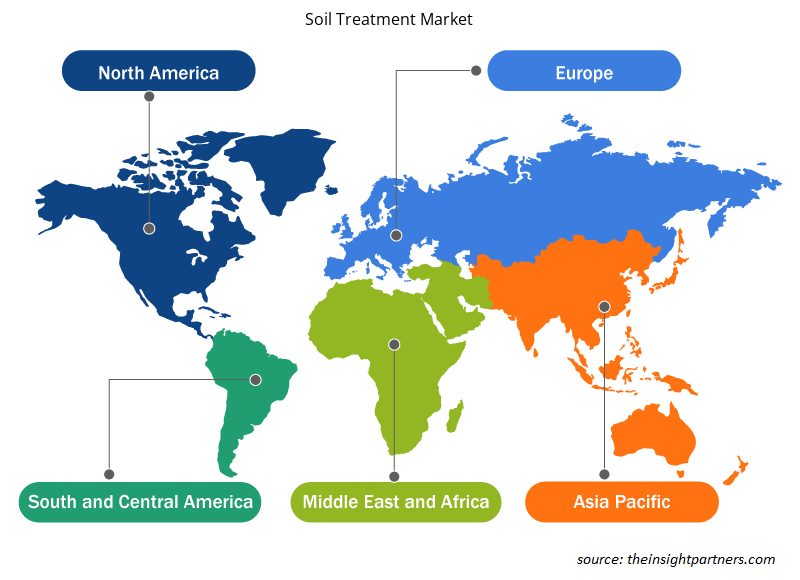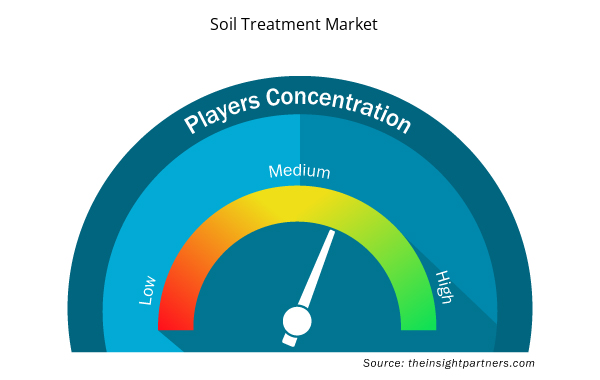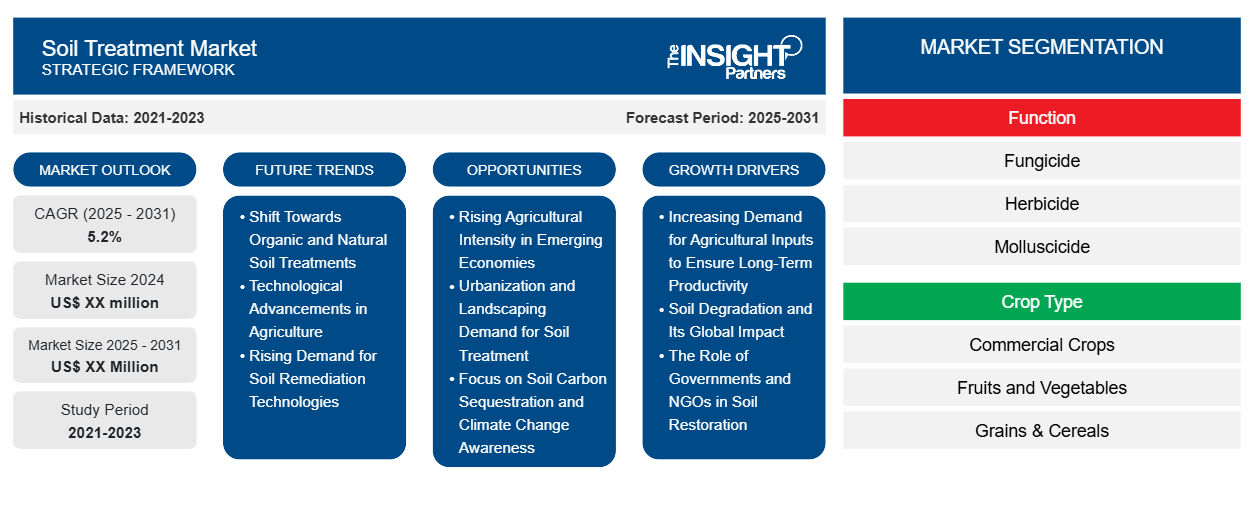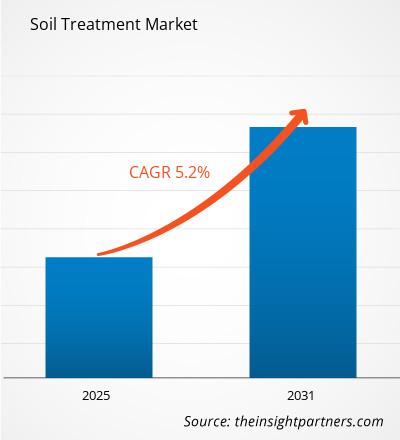Se espera que el mercado de tratamiento de suelos registre una CAGR del 5,2% entre 2024 y 2031, con un tamaño de mercado que se expandirá de US$ XX millones en 2024 a US$ XX millones en 2031.
El informe está segmentado por función (fungicida, herbicida, molusquicida, insecticida y nematicida). El informe presenta además un análisis basado en el tipo de cultivo (cultivos comerciales, frutas y verduras, granos y cereales, legumbres y semillas oleaginosas, y césped y plantas ornamentales). El alcance del informe cubre cinco regiones: América del Norte, Europa, Asia Pacífico, Medio Oriente y África, y América del Sur y Central y los países clave de cada región. El análisis global se desglosa aún más a nivel regional y por países principales. El informe ofrece el valor en USD para el análisis y los segmentos anteriores.
Propósito del Informe
El informe Soil Treatment Market de The Insight Partners tiene como objetivo describir el panorama actual y el crecimiento futuro, los principales factores impulsores, los desafíos y las oportunidades. Esto proporcionará información a diversas partes interesadas del negocio, como:
- Proveedores/fabricantes de tecnología: Para comprender la dinámica cambiante del mercado y conocer las oportunidades potenciales de crecimiento, lo que les permitirá tomar decisiones estratégicas informadas.
- Inversionistas: Realizar un análisis exhaustivo de tendencias sobre la tasa de crecimiento del mercado, las proyecciones financieras del mercado y las oportunidades que existen en toda la cadena de valor.
- Órganos reguladores: Regular las políticas y vigilar las actividades del mercado con el objetivo de minimizar los abusos, preservar la confianza de los inversores y defender la integridad y la estabilidad del mercado.
Segmentación del mercado de tratamiento de suelos
Función
- Fungicida
- Herbicida
- Molusquicida
- Insecticida
- Nematicida
Tipo de cultivo
- Cultivos comerciales
- Frutas y verduras
- Granos y cereales
- Legumbres y semillas oleaginosas
- Césped y plantas ornamentales
Personalice este informe según sus necesidades
Obtendrá personalización en cualquier informe, sin cargo, incluidas partes de este informe o análisis a nivel de país, paquete de datos de Excel, así como también grandes ofertas y descuentos para empresas emergentes y universidades.
- Obtenga las principales tendencias clave del mercado de este informe.Esta muestra GRATUITA incluirá análisis de datos, desde tendencias del mercado hasta estimaciones y pronósticos.
Factores impulsores del crecimiento del mercado de tratamiento de suelos
- Demanda creciente de insumos agrícolas para garantizar la productividad a largo plazo: el aumento de la población mundial y la necesidad de productos agrícolas exigen mayores insumos para el suelo a fin de lograr un tratamiento adecuado que garantice la productividad agrícola a largo plazo y la disponibilidad de una producción alimentaria sostenible. La fertilización, el ajuste del pH y las enmiendas orgánicas utilizadas en el tratamiento del suelo son fundamentales, ya que influyen en la salud del suelo y la maximización del rendimiento de los cultivos y garantizan la productividad agrícola a largo plazo y la mejora de la producción. Una alta producción agrícola exige una solución más eficiente para su tratamiento.
- La degradación del suelo y su impacto global: El uso excesivo de tierras agrícolas, la deforestación, la industrialización y el calentamiento global asociado con la degradación del suelo amenazan al mundo. Los principales desafíos que se encuentran en este aspecto incluyen la erosión del suelo, el agotamiento de los nutrientes y la contaminación. Esto ha exigido la adopción de medidas de acondicionamiento del suelo, control de la erosión del suelo y remediación, aumentando así la restauración y conservación de suelos saludables. Los gobiernos, las ONG y las industrias afiliadas a la agroindustria tienen interés en tratar el suelo como un medio para revertir los efectos nocivos acumulados de las consecuencias de la gestión inadecuada del suelo.
- El papel de los gobiernos y las ONG en la restauración del suelo: la creciente conciencia de los factores ambientales y las estrictas regulaciones gubernamentales con respecto al tratamiento del suelo con productos agrícolas sostenibles están impulsando la adopción de productos para el tratamiento del suelo. Los tratamientos orgánicos y respetuosos con el medio ambiente, al ser ecológicos, son la primera opción para los agricultores, ya que los clientes tienden a hacer un uso mínimo de productos químicos en la agricultura y evitan la contaminación del suelo y el agua. Las regulaciones agrícolas exigen que el tratamiento del suelo adopte estrictamente los principios agrícolas para una agricultura segura y saludable.
Tendencias futuras del mercado de tratamiento de suelos
- Cambio hacia tratamientos orgánicos y naturales del suelo: los tratamientos orgánicos y naturales del suelo, como el compost, el biocarbón y los fertilizantes de origen vegetal, están en auge. Esto se debe a que los consumidores prefieren más productos orgánicos y a que las regulaciones ambientales más estrictas imponen una gestión del suelo no tóxica y sostenible. Los tratamientos del suelo de origen biológico también están en auge debido a que son más respetuosos con el medio ambiente y más seguros que los productos químicos sintéticos.
- Avances tecnológicos en la agricultura: Las nuevas tecnologías y su adopción en la agricultura modifican la forma en que se trata el suelo. El análisis de datos, los dispositivos IoT, los drones y otros sensores dominan la capacidad de participar en la agricultura de precisión. También se lleva a cabo un seguimiento oportuno de las condiciones del suelo con la ayuda de tratamientos específicos. Estas tecnologías garantizan que los fertilizantes del suelo no se desperdicien al minimizar los desechos y lograr una eficiencia general óptima en las aplicaciones realizadas en el tratamiento del suelo. Es probable que el uso de tecnología más accesible aumente la participación de esa tecnología en el mercado del tratamiento del suelo.
- Demanda creciente de tecnologías de remediación de suelos: la creciente demanda de tecnologías de remediación de suelos se debe a la contaminación del suelo con metales pesados, pesticidas, desechos industriales y otros contaminantes. La creciente demanda de tecnologías de remediación ecológica, como la biorremediación y la fitorremediación para la descontaminación y la recuperación de suelos contaminados, ha comenzado a mostrar fortaleza en el mercado. Las principales fuerzas impulsoras de esta tendencia son una mayor conciencia ambiental, la nueva legislación sobre contaminación industrial y la necesidad de tierras limpias y saludables para la agricultura y las necesidades urbanas.
Oportunidades de mercado en el tratamiento de suelos
- Aumento de la intensidad agrícola en las economías emergentes: El aumento de la intensidad agrícola en las economías emergentes, especialmente en Asia-Pacífico, América Latina y África, está aumentando la demanda de tecnologías de tratamiento del suelo. Los mismos problemas que aquejan a estas economías emergentes (malas prácticas de gestión del suelo y sobreexplotación agrícola en muchas partes de ellas) son oportunidades para las empresas que se dedican a tecnologías de tratamiento del suelo como enmiendas orgánicas, control del pH y restauración de la salud del suelo.
- Demanda de tratamiento de suelos en urbanización y paisajismo: Con la creciente urbanización y comercialización, la necesidad de tratamiento de suelos en proyectos de paisajismo está en constante aumento. Se ha convertido en un requisito esencial para ayudar al crecimiento de las plantas en condiciones urbanas adversas, desde parques urbanos hasta techos verdes y campos deportivos. Los acondicionadores de suelos, fertilizantes y materiales de control de la erosión son de vital importancia para cuidar de ciudades saludables y sostenibles. Esto, a su vez, se convierte en una nueva oportunidad de desarrollo de mercado para las empresas que tratan el suelo.
- Enfoque en el secuestro de carbono del suelo y concienciación sobre el cambio climático: Junto con la creciente concienciación sobre el cambio climático, el enfoque en el secuestro de carbono del suelo está aumentando de forma lenta pero constante. Entre ellos se encuentran grandes cantidades de biocarbón, compost y cultivos de cobertura, que, en consecuencia, son capaces de mejorar la capacidad de captura y almacenamiento del suelo. Estos métodos están ganando reconocimiento como parte de iniciativas más amplias de cultivo de carbono que abren nuevas vías para las empresas que desarrollan tratamientos del suelo que apoyan los esfuerzos de secuestro de carbono.
Perspectivas regionales del mercado de tratamiento de suelos
Los analistas de Insight Partners explicaron en detalle las tendencias y los factores regionales que influyen en el mercado de tratamiento de suelos durante el período de pronóstico. Esta sección también analiza los segmentos y la geografía del mercado de tratamiento de suelos en América del Norte, Europa, Asia Pacífico, Medio Oriente y África, y América del Sur y Central.

- Obtenga datos regionales específicos para el mercado de tratamiento de suelos
Alcance del informe de mercado sobre tratamiento de suelos
| Atributo del informe | Detalles |
|---|---|
| Tamaño del mercado en 2024 | XX millones de dólares estadounidenses |
| Tamaño del mercado en 2031 | US$ XX millones |
| Tasa de crecimiento anual compuesta (CAGR) global (2025-2031) | 5,2% |
| Datos históricos | 2021-2023 |
| Período de pronóstico | 2025-2031 |
| Segmentos cubiertos | Por función
|
| Regiones y países cubiertos | América del norte
|
| Líderes del mercado y perfiles de empresas clave |
|
Densidad de actores del mercado de tratamiento de suelos: comprensión de su impacto en la dinámica empresarial
El mercado de tratamiento de suelos está creciendo rápidamente, impulsado por la creciente demanda de los usuarios finales debido a factores como la evolución de las preferencias de los consumidores, los avances tecnológicos y una mayor conciencia de los beneficios del producto. A medida que aumenta la demanda, las empresas amplían sus ofertas, innovan para satisfacer las necesidades de los consumidores y aprovechan las tendencias emergentes, lo que impulsa aún más el crecimiento del mercado.
La densidad de actores del mercado se refiere a la distribución de las empresas o firmas que operan dentro de un mercado o industria en particular. Indica cuántos competidores (actores del mercado) están presentes en un espacio de mercado determinado en relación con su tamaño o valor total de mercado.
Las principales empresas que operan en el mercado de tratamiento de suelos son:
- ADAMA Soluciones Agrícolas Ltd.
- Corporación Vanguardista Americana
- Arkema SA
- BASF SE
- Tratamiento de suelos Kanesho
Descargo de responsabilidad : Las empresas enumeradas anteriormente no están clasificadas en ningún orden particular.

- Obtenga una descripción general de los principales actores clave del mercado de tratamiento de suelos
Puntos de venta clave
- Cobertura integral: el informe cubre de manera integral el análisis de productos, servicios, tipos y usuarios finales del mercado de tratamiento de suelos, proporcionando un panorama holístico.
- Análisis de expertos: el informe se compila sobre la base de un profundo conocimiento de expertos y analistas de la industria.
- Información actualizada: El informe asegura relevancia comercial debido a su cobertura de información reciente y tendencias de datos.
- Opciones de personalización: este informe se puede personalizar para satisfacer los requisitos específicos del cliente y adaptarse adecuadamente a las estrategias comerciales.
Por lo tanto, el informe de investigación sobre el mercado de tratamiento de suelos puede ayudar a abrir camino para descifrar y comprender el escenario de la industria y las perspectivas de crecimiento. Si bien puede haber algunas preocupaciones válidas, los beneficios generales de este informe tienden a superar las desventajas.
- Análisis histórico (2 años), año base, pronóstico (7 años) con CAGR
- Análisis PEST y FODA
- Tamaño del mercado Valor/volumen: global, regional, nacional
- Industria y panorama competitivo
- Conjunto de datos de Excel


- Collagen Peptides Market
- Ketogenic Diet Market
- Enzymatic DNA Synthesis Market
- Electronic Signature Software Market
- Rare Neurological Disease Treatment Market
- Smart Mining Market
- Vision Care Market
- Hydrolyzed Collagen Market
- Transdermal Drug Delivery System Market
- Artificial Intelligence in Healthcare Diagnosis Market

Report Coverage
Revenue forecast, Company Analysis, Industry landscape, Growth factors, and Trends

Segment Covered
This text is related
to segments covered.

Regional Scope
North America, Europe, Asia Pacific, Middle East & Africa, South & Central America

Country Scope
This text is related
to country scope.
Preguntas frecuentes
Increased use of technological solutions (precision agriculture) is expected to be the key market trend.
The report can be delivered in PDF/Word format, we can also share excel data sheet based on request.
On the basis of geography, the soft magnetic composite market is classified into North America, Europe, Asia Pacific, Middle East and Africa, and South and Central America
ADAMA Agricultural Solutions Ltd, American Vanguard Corp, BASF SE, Bayer AG, FMC Corp, Nufarm Ltd, PI Industries Group, Rallis India Ltd, Syngenta AG, and UPL Ltd
The major factors driving the soil treatment market are:
1. Increasing Agricultural Demand and Food Security.
2. Soil Degradation and Erosion.
The Soil Treatment Market is estimated to witness a CAGR of 5.2% from 2023 to 2031
Trends and growth analysis reports related to Chemicals and Materials : READ MORE..
The List of Companies
1. ADAMA Agricultural Solutions Ltd.
2. American Vanguard Corporation
3. Arkema S.A.
4. BASF SE
5. Kanesho Soil Treatment
6. Monsanto Company
7. Novozymes A/S
8. Platform Specialty Products
9. Solvay S.A.
10. Syngenta AG
The Insight Partners performs research in 4 major stages: Data Collection & Secondary Research, Primary Research, Data Analysis and Data Triangulation & Final Review.
- Data Collection and Secondary Research:
As a market research and consulting firm operating from a decade, we have published and advised several client across the globe. First step for any study will start with an assessment of currently available data and insights from existing reports. Further, historical and current market information is collected from Investor Presentations, Annual Reports, SEC Filings, etc., and other information related to company’s performance and market positioning are gathered from Paid Databases (Factiva, Hoovers, and Reuters) and various other publications available in public domain.
Several associations trade associates, technical forums, institutes, societies and organization are accessed to gain technical as well as market related insights through their publications such as research papers, blogs and press releases related to the studies are referred to get cues about the market. Further, white papers, journals, magazines, and other news articles published in last 3 years are scrutinized and analyzed to understand the current market trends.
- Primary Research:
The primarily interview analysis comprise of data obtained from industry participants interview and answers to survey questions gathered by in-house primary team.
For primary research, interviews are conducted with industry experts/CEOs/Marketing Managers/VPs/Subject Matter Experts from both demand and supply side to get a 360-degree view of the market. The primary team conducts several interviews based on the complexity of the markets to understand the various market trends and dynamics which makes research more credible and precise.
A typical research interview fulfils the following functions:
- Provides first-hand information on the market size, market trends, growth trends, competitive landscape, and outlook
- Validates and strengthens in-house secondary research findings
- Develops the analysis team’s expertise and market understanding
Primary research involves email interactions and telephone interviews for each market, category, segment, and sub-segment across geographies. The participants who typically take part in such a process include, but are not limited to:
- Industry participants: VPs, business development managers, market intelligence managers and national sales managers
- Outside experts: Valuation experts, research analysts and key opinion leaders specializing in the electronics and semiconductor industry.
Below is the breakup of our primary respondents by company, designation, and region:

Once we receive the confirmation from primary research sources or primary respondents, we finalize the base year market estimation and forecast the data as per the macroeconomic and microeconomic factors assessed during data collection.
- Data Analysis:
Once data is validated through both secondary as well as primary respondents, we finalize the market estimations by hypothesis formulation and factor analysis at regional and country level.
- Macro-Economic Factor Analysis:
We analyse macroeconomic indicators such the gross domestic product (GDP), increase in the demand for goods and services across industries, technological advancement, regional economic growth, governmental policies, the influence of COVID-19, PEST analysis, and other aspects. This analysis aids in setting benchmarks for various nations/regions and approximating market splits. Additionally, the general trend of the aforementioned components aid in determining the market's development possibilities.
- Country Level Data:
Various factors that are especially aligned to the country are taken into account to determine the market size for a certain area and country, including the presence of vendors, such as headquarters and offices, the country's GDP, demand patterns, and industry growth. To comprehend the market dynamics for the nation, a number of growth variables, inhibitors, application areas, and current market trends are researched. The aforementioned elements aid in determining the country's overall market's growth potential.
- Company Profile:
The “Table of Contents” is formulated by listing and analyzing more than 25 - 30 companies operating in the market ecosystem across geographies. However, we profile only 10 companies as a standard practice in our syndicate reports. These 10 companies comprise leading, emerging, and regional players. Nonetheless, our analysis is not restricted to the 10 listed companies, we also analyze other companies present in the market to develop a holistic view and understand the prevailing trends. The “Company Profiles” section in the report covers key facts, business description, products & services, financial information, SWOT analysis, and key developments. The financial information presented is extracted from the annual reports and official documents of the publicly listed companies. Upon collecting the information for the sections of respective companies, we verify them via various primary sources and then compile the data in respective company profiles. The company level information helps us in deriving the base number as well as in forecasting the market size.
- Developing Base Number:
Aggregation of sales statistics (2020-2022) and macro-economic factor, and other secondary and primary research insights are utilized to arrive at base number and related market shares for 2022. The data gaps are identified in this step and relevant market data is analyzed, collected from paid primary interviews or databases. On finalizing the base year market size, forecasts are developed on the basis of macro-economic, industry and market growth factors and company level analysis.
- Data Triangulation and Final Review:
The market findings and base year market size calculations are validated from supply as well as demand side. Demand side validations are based on macro-economic factor analysis and benchmarks for respective regions and countries. In case of supply side validations, revenues of major companies are estimated (in case not available) based on industry benchmark, approximate number of employees, product portfolio, and primary interviews revenues are gathered. Further revenue from target product/service segment is assessed to avoid overshooting of market statistics. In case of heavy deviations between supply and demand side values, all thes steps are repeated to achieve synchronization.
We follow an iterative model, wherein we share our research findings with Subject Matter Experts (SME’s) and Key Opinion Leaders (KOLs) until consensus view of the market is not formulated – this model negates any drastic deviation in the opinions of experts. Only validated and universally acceptable research findings are quoted in our reports.
We have important check points that we use to validate our research findings – which we call – data triangulation, where we validate the information, we generate from secondary sources with primary interviews and then we re-validate with our internal data bases and Subject matter experts. This comprehensive model enables us to deliver high quality, reliable data in shortest possible time.


 Obtenga una muestra gratuita de este informe
Obtenga una muestra gratuita de este informe